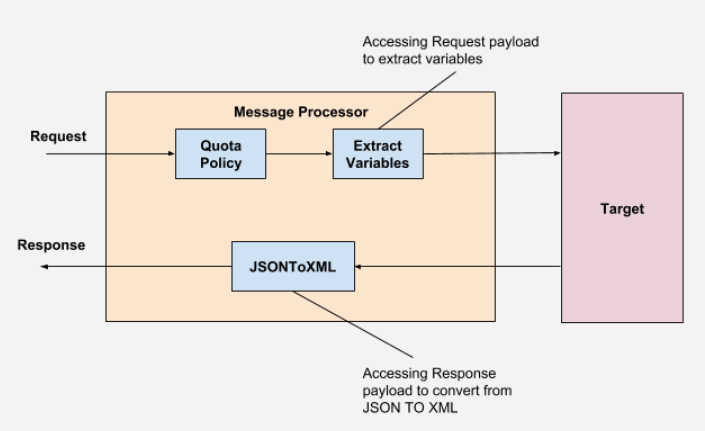反模式:在启用流式传输时访问请求/响应载荷
使用集合让一切井井有条
根据您的偏好保存内容并对其进行分类。
您正在查看 Apigee 和 Apigee Hybrid 文档。
查看 Apigee Edge 文档。
在 Apigee 中,默认行为是将 HTTP 请求和响应载荷存储在内存中缓冲区中,然后由 API 代理中的政策处理。
如果启用流式传输,则系统将对请求和响应载荷进行流式传输,而无需修改客户端应用(响应)和目标端点(请求)。如果应用接受或返回大型载荷,或者有个应用会在一段时间内返回区块数据,流式传输尤为有用。
反模式
在启用流处理的情况下访问请求/响应载荷会导致 Apigee 返回默认缓冲模式。
 图 1:在启用流式传输的情况下访问请求/响应载荷
图 1:在启用流式传输的情况下访问请求/响应载荷
上图显示,我们正在尝试从请求载荷中提取变量,并使用 JSONToXML 政策将 JSON 响应载荷转换为 XML。这将在 Apigee 中停用流式传输。
影响
- 系统将停用流式插入,这可能会导致数据处理的延迟时间增加
- 由于使用内存缓冲区,特别是有大型请求/响应载荷时,可以在消息处理器上观察到堆内存用量增加或
OutOfMemory 错误
最佳做法
更多详情
如未另行说明,那么本页面中的内容已根据知识共享署名 4.0 许可获得了许可,并且代码示例已根据 Apache 2.0 许可获得了许可。有关详情,请参阅 Google 开发者网站政策。Java 是 Oracle 和/或其关联公司的注册商标。
最后更新时间 (UTC):2025-10-06。
[[["易于理解","easyToUnderstand","thumb-up"],["解决了我的问题","solvedMyProblem","thumb-up"],["其他","otherUp","thumb-up"]],[["很难理解","hardToUnderstand","thumb-down"],["信息或示例代码不正确","incorrectInformationOrSampleCode","thumb-down"],["没有我需要的信息/示例","missingTheInformationSamplesINeed","thumb-down"],["翻译问题","translationIssue","thumb-down"],["其他","otherDown","thumb-down"]],["最后更新时间 (UTC):2025-10-06。"],[],[]]

